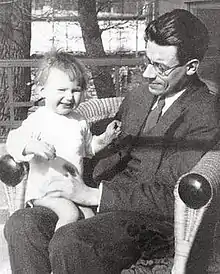Wilhelm Guddorf
Wilhelm Guddorf (alias Paul Braun; 20 February 1902 – 13 May 1943) was a journalist and resistance fighter against the Third Reich. He was reputedly a member of the Red Orchestra (Rote Kapelle) resistance group.[1] Guddorf was the editor of the Die Rote Fahne (The Red Flag) newspaper.[2]
Wilhelm Guddorf | |
|---|---|
 Wilhelm Guddorf holding a young child. | |
| Born | 20 February 1902 Melle, Belgium |
| Died | 13 May 1943 (aged 41) Plötzensee Prison, Berlin, Germany |
| Nationality | Belgian |
| Organization | Journalist |
Life
Born in Melle, Belgium, Guddorf completed studies in philology. In 1922, he joined the Communist Party of Germany (KPD) and from 1923 worked for several of the party's newspapers. After the Nazi party seized power in 1933, he began distributing articles against the régime under his alias. He was arrested in April 1934 and later sentenced to hard labour at the Sachsenhausen concentration camp, where he was held until 1939.
After he was released from Sachsenhausen, Guddorf developed contacts with the Red Orchestra and introduced Eva-Maria Buch to the group.[3] He was arrested once again in 1942 and in February 1943 was sentenced to death. He was executed at Plötzensee Prison in Berlin on 13 May. In 1972, a street in Lichtenberg, a Berlin borough, was named after Guddorf.
Leafletting
Guddorf was known to have written some of the Agis leaflets.[4] The leaflets were produced by the Harnack and Schulze-Boysen Groups and had names like What is a Majority, Freedom and Violence and Call to the workers of the mind and fist not to fight against Russia. The Agis was a reference to the Spartan King Agis IV. The leaflets were distributed in Berlin and Germany.
Award and honours
- In 1972, the Berlin district of Lichtenberg named a street after Guddorf. The street is known as Wilhelm-Guddorf-Straße. The street is one of many that were renamed to honour the Rote Kapelle members e.g. Mildred-Harnack-Straße, Schulze-Boysen-Straße.[5]
- In 1971, in the Berlin district of Köpenick a school in Rahnsdorf was renamed to Wilhelm Guddorf High School, Wilhelm-Guddorf-Oberschule[6] The name remained in place until the Socialist Unity Party of Germany was dissolved and the German reunification commenced and by 1992 the parents, teachers and students decided to rename the school to Elementary School on the Püttbergen.
Literature
- Coppi junior, Hans; Danyel, Jürgen; Tuchel, Johannes (1992). Die Rote Kapelle im Widerstand gegen Nationalsozialismus [The Red Chapel in opposition to Hitler. Writings of the Memorial of the German Resistance] (in German) (1st ed.). Berlin: Edition Hentrich. ISBN 978-3-89468-110-4.
- Rosiejka, Gert (1986). Die Rota Kappelle : Landesverrat als antifaschististischer Widerstand [The Rota Kappelle : Treason as an anti-fascist resistance] (in German) (1. ed.). Hamburg: Ergebnisse Verlag. ISBN 9783925622168. OCLC 497259004.
- Weber, Hermann; Herbst, Andreas (2008). Deutsche Kommunisten : biographisches Handbuch 1918 bis 1945 [German Communists : Biographical Manual 1918 to 1945] (in German) (2. ed.). Berlin: K. Dietz. ISBN 978-3-320-02130-6. OCLC 269406597.
- Hochmuth, Ursel; Meyer, Gertrud (1980). Streiflichter aus dem Hamburger Widerstand : 1933-1945 [Streiflichter from the Hamburg Resistance : 1933-1945]. Bibliothek des Widerstandes (in German). Frankfurt: Röderberg-Verl. pp. 341–386. ISBN 9783876820361. OCLC 633634339.
- Siegfried, Mielke; Heinz, Stefan (2017). Eisenbahngewerkschafter im NS-Staat : Verfolgung - Widerstand - Emigration (1933-1945) [Railway unionists in the Nazi state. Persecution - Resistance - Emigration (1933-1945)]. Gewerkschafter im Nationalsozialismus (in German). 7. Berlin: Metropol-Verlag. ISBN 9783863313531. OCLC 1015203638.
- Luise Kraushaar; Klaus Drobisch; Gertrud Glondajewski; Hans Dress; Institut für Marxismus-Leninismus. Deutsche Widerstandskämpfer 1933-1945 : Biographien und Briefe. Band 2 [German Resistance Fighters 1933-1945 : Biographies and Letters] (in German). 2. Berlin: Dietz Verlag. pp. 345–347. OCLC 758497937.
References
- "Wilhelm Guddorf". Gedenkstätte Deutscher Widerstand. German Resistance Memorial Center. Retrieved 25 May 2019.
- Shareen Blair Brysac (23 May 2002). Resisting Hitler: Mildred Harnack and the Red Orchestra. Oxford University Press. p. 206. ISBN 978-0-19-992388-5. Retrieved 6 February 2019.
- Cook, Bernard A. (2006). Women and War: A Historical Encyclopedia from Antiquity to the Present, Vol. 1, p. 90. ABC-CLIO, Inc.
- Corina L. Petrescu (2010). Against All Odds: Models of Subversive Spaces in National Socialist Germany. Peter Lang. p. 199. ISBN 978-3-03911-845-8. Retrieved 6 February 2019.
- Alexander-Martin Sardina (10 May 2019). "Hello, girls and boys!": Fremdsprachenunterricht in der SBZ und DDR. Wolff Verlag. p. 236. ISBN 978-3-941461-28-4. Retrieved 28 September 2019.
- "Chronik der "Grundschule an den Püttbergen"" (Word). School at the Puettbergen (in German). Puettbergen. 1999. Retrieved 28 September 2019.
External links
- (in German) Wilhelm-Guddorf-Straße